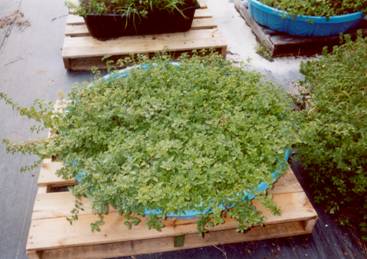Suitability of Oregano as a Commercial Culinary Herb Crop-2004 Report
go.ncsu.edu/readext?441647
en Español / em Português
El inglés es el idioma de control de esta página. En la medida en que haya algún conflicto entre la traducción al inglés y la traducción, el inglés prevalece.
Al hacer clic en el enlace de traducción se activa un servicio de traducción gratuito para convertir la página al español. Al igual que con cualquier traducción por Internet, la conversión no es sensible al contexto y puede que no traduzca el texto en su significado original. NC State Extension no garantiza la exactitud del texto traducido. Por favor, tenga en cuenta que algunas aplicaciones y/o servicios pueden no funcionar como se espera cuando se traducen.
Português
Inglês é o idioma de controle desta página. Na medida que haja algum conflito entre o texto original em Inglês e a tradução, o Inglês prevalece.
Ao clicar no link de tradução, um serviço gratuito de tradução será ativado para converter a página para o Português. Como em qualquer tradução pela internet, a conversão não é sensivel ao contexto e pode não ocorrer a tradução para o significado orginal. O serviço de Extensão da Carolina do Norte (NC State Extension) não garante a exatidão do texto traduzido. Por favor, observe que algumas funções ou serviços podem não funcionar como esperado após a tradução.
English
English is the controlling language of this page. To the extent there is any conflict between the English text and the translation, English controls.
Clicking on the translation link activates a free translation service to convert the page to Spanish. As with any Internet translation, the conversion is not context-sensitive and may not translate the text to its original meaning. NC State Extension does not guarantee the accuracy of the translated text. Please note that some applications and/or services may not function as expected when translated.
Collapse ▲This is a 2004 report from a NC Specialty Crops Program Project. It is posted for historical reference purposes.
PROJECT LEADER(S): Willie Wilson for Jerry Walden
LOCATION: Estelle Farms, 4650 White Store Rd., Wingate, NC 28174
IMPACT
Demand for fresh cut culinary herbs is increasing in the southern piedmont region of NC. Initial trials show that Oregano can be grown in North Carolina as a commercial culinary herb crop.
INTRODUCTION
There are few culinary herb growers in NC. The market has dramatically increased in the past few years and based on trends, will continue to grow. Oreganos hybridize readily, so root division is the most reliable form of propagation. There are several varieties most of which are not suitable for culinary use, so care must be taken initially when selecting plants.
METHODS
Oregano is extremely invasive and must be grown in enclosed area or container. We found that for ease of planting and harvesting, the best containers are five foot diameter kiddie wading pools. Several holes were punched in the bottom of the pool for drainage. The pools were then placed on pallets and filled to depth of six inches with a peat lite potting mix consisting of 55% Canadian Sphagnum Peat, perlite, and vermiculite. Root cuttings were planted on a spacing of five inches on center. Once the plants started to grow, approximately seven days, they were placed on a 30 day fertilizer cycle using a standard 15-30-15 mix. Water was applied as necessary to maintain a moist, but not wet, soil condition.
RESULTS
The time from planting to first harvest was eight weeks. First harvest yielded 1lb per 20 square foot of growing space. As the plants propagated over the next six months, yields increased to 1lb per 10 square feet. It is worthy to note that the small leaf and stem size of oregano requires a relatively large space to yield ratio. Oregano goes dormant during the winter, and so it is only viable as an outside crop for about seven months. Once established, it will come back in the spring
CONCLUSION
Oregano can be successfully grown in this region of NC.
TABLES & PHOTOS
Reviewed by Jeanine Davis, NC Alternative Crops & Organics Program, Department of Horticultural Science, NC State University on 7/26/2022.



